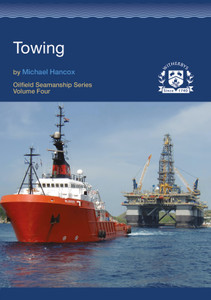
This volume covers the use of spread mooring systems in the context of barges. It deals with both static (drilling unit/support ship) and mobile (pipelaying/trenching) mooring spreads. The book will assist barge Masters, barge movers, tower foremen, barge engineers, marine advisors, warranty surveyors and others to use ‘in the field’ to assist them in their work. Previously published by Clarkson Research Services Ltd.
This book concentrates on the mooring systems of semi-submersibles, but the procedures and equipment used can apply to other types of specialist vessels. It includes practical guidance on topics such as anchor types. The text is supported by detailed diagrams of concepts such as deployment theory, as well as graphical presentation of anchor holding capacity. Other topics detailed include mooring equipment, the problems associated with anchoring equipment and advice on operational safety.
Part
1
Anchor
Theory
and
Practice
1.1
Catenary
mooring
system
theory
1.2
Design
of
spread
mooring
systems
1.3
Oil
industry
anchors
1.4
Anchor
types
and
behaviour
1.5
Method
of
operation
HHP
anchors
1.6
Predicting
holding
power
1.7
Frictional
resistance
of
the
anchor
line
1.8
Soil
description
and
drag
anchor
factors
1.9
Soil
classification
table
1.10
Improving
anchor
performance
1.11
Anchor
cable
catenary
data
and
its
uses
1.12
Running
HHP
anchors
in
very
hard
ground
1.13
Mooring
calculations
1.14
Working
tension/initial
pretension
and
storm
loads
1.15
Anchor
running
tables
(chain
moorings)
1.16
Minimum
deployed
length
–
test
and
working
tensions
Part
2
Mooring
Equipment
2.1
Anchors
2.2
Anchor
line
–
wire
and
chain
2.3
Anchor
rigging
2.4
Anchor
chasers
2.5
Drop
anchor
rigging
2.6
Permanent
chain
chaser
pennants
2.7
Anchor
shackles
tables
and
dimensions
2.8
Bulldog
grip
table
2.9
Attachment
of
anchor
to
anchor
line
2.10
Pennant
connection
pigtails
2.11
Pennant
lines
2.12
Pennants
–
use
of
pigtails
and
rigging
2.13
Open
and
closed
spelter
sockets
2.14
Pennant
wire
–
standard
lengths
and
coding
2.15
Anchor
buoys
2.16
Clump
weights
Part
3
Anchor
Patterns
3.1
Anchor
patterns
Part
4
Planning
Mooring
Operations
4.1
Basic
planning
steps
4.2
Planning
questions
to
be
answered
4.3
Mooring
plan
4.4
Anchor
handling
vessels
4.5
Positioning
systems
4.6
Rig
move
procedure
4.7
Site
surveys
4.8
Approvals
and
permissions
4.9
Positioning
systems
–
requirements
and
capabilities
4.10
Anchor
handling
vessel
requirements
-
what
type
and
how
much
power
is
needed?
4.11
Briefing
and
discussion
with
workboats
4.12
Basic
rules
of
anchor
work
4.13
Operational
cautions
–
notes
on
good
practice
4.14
Going
onto
location
4.15
Departure
from
location
4.16
Crew
deployment
and
briefing
4.17
Anchor
handling
orders/advice
and
vocabulary
4.18
Positioning
system
checks
–
going
onto
location
4.19
Re-running,
test
tensioning
and
final
positioning
4.20
Verifying
mooring
line
position
in
tight
locations
4.21
Equipment
checks
for
anchoring
machinery
4.22
The
anchor
handling
basket
4.23
Check
list
for
anchor
handling
4.24
Anchor
handling
plan
and
procedure
4.25
Marine
procedures
Part
5
Running
and
Retrieving
Anchors
5.1
Running
anchors
–
summary
of
operations
5.2
Running
anchors
–
sequence
of
events
5.3
Retrieving
anchors
–
permanent
chain
chaser
systems
5.4
Retrieving
anchors
–
buoyed
systems
5.5
Passing
pennant
wires
5.6
Breaking
chain
out
of
sticky
ground
5.7
Racking
anchors
Part
6
Specialised
Anchor
Work
6.1
Introduction
to
specialist
mooring
operations
6.2
Two
boat
operations
–
laying
and
retrieving
anchors
6.3
Mooring
on
smooth
rock
bottoms
6.4
Confined
space
short
mooring
–
doubled
chain
6.5
Interference
mooring
6.6
Anchoring
sequence
6.7
Anchoring
sequence
–
running
anchor
through
flare
bridge
6.8
Support
mooring
operation
6.9
Support
mooring
6.10
Jack-up
positioning/mooring
operations
with
interference/cross
line
problems
6.11
Mooring
over
obstructions
without
support
buoys
6.12
Installation
of
single
buoy
moorings
(SBMs)
6.13
Special
moorings
Part
7
Mooring
Problems
–
piggy
backing,
fishing
and
fouling
7.1
Piggy
back
anchor
work
7.2
Fishing
and
grappling
7.3
Problems
with
anchoring
equipment
7.4
Gypseywear
7.5
Windlass
drive
teeth
damage
and
wear
7.6
Spurling
pipe
wear
Part
8
Pipelaying
Barge
Mooring
Work
8.1
Plotting
anchor
movements
8.2
Pipeline
crossing
operations
8.3
Temporary
buoys
8.4
Temporary
pipeline
crossing
arrangements
8.5
Beach
pull
operations
8.6 Cautionary note – limits of weather working
Part 9 Heavy Lift Barge Operations
Part
10
Operational
Safety
10.1
Risks
on
the
anchor
handling
boat
10.2
Risks
on
the
barge
Part 11 Positioning Systems
Part 12 Boat Selection and Capability
Part
13
Mooring
System
Management
13.1
Introduction
13.2
Daily
routine
13.3
Moving
the
vessel
within
the
anchor
spread
Part
14
Anchor
Winch
Operation
14.1
General
remarks
14.2
Basic
operational
precautions
14.3
Specialised
barge
winches
14.4
Emergency
release
14.5
Electrically
driven
winches
–
features
14.6
Notes
on
mooring
line
length
and
tension
devices
14.7
Operators’
instructions
14.8
Trouble
shooting
14.9
Weekly
anchor
winch
tests
Part
15
Anchor
Line
Inspection
15.1
Chain
mooring
line
damage
types
–
symptoms,
causes
and
remedies
15.2
Visual
examination
of
chain
cable
15.3
Detailed
specialist
examination
15.4
The
use
of
replacement
anchor
chain
studs
(gem
stud
type)
15.5
Mechanical
properties
of
chain
grade
steel
15.6
Procedure
for
chain
inspection
–
notes
15.7
Wire
mooring
line
inspection
and
maintenance
guidelines
Part 16 Anchor Handling Reports
Part 17 Adverse Weather and Working Limits Data
Michael
Hancox
Captain
Michael
Hancox
is
a
Marine
Consultant
and
former
Director
of
Hancox
Marine
Services
Limited.
Witherbys
Witherbys
titles
are
developed
using
scripts
developed
by
technical
experts
that
are
peer
reviewed
within
work
groups.
Typically,
they
seek
to
improve
understanding
of
the
regulations,
recommendations
and
guidelines
issued
by
Industry.
Witherbys staff have significant expertise in the fields of navigation and hazardous cargoes as well as in the presentation of complex subjects in a graphic and easy to understand manner.
- Number of Pages:
- 500
- ISBN:
- 9781870945752
- Published Date:
- November 2005
- Binding Format:
- Paperback
- Book Height:
- 295 mm
- Book Width:
- 205 mm
- Weight:
- 2.1 kg
- Author:
Michael Hancox and Witherbys
- Preview:
- Yes
 Witherbys.com
Witherbys.com




